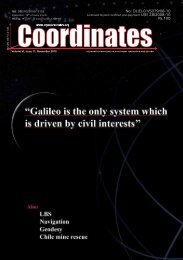positioning - Coordinates
positioning - Coordinates
positioning - Coordinates
You also want an ePaper? Increase the reach of your titles
YUMPU automatically turns print PDFs into web optimized ePapers that Google loves.
we have a network of organisations with<br />
different responsibilities goals and agenda<br />
and we need to under the basis on tradeoffs<br />
are made. The Netherlands Gideon<br />
project offers excellent direction.[Gideon]<br />
Further there is increasingly there is a<br />
demand for open government: citizencentric<br />
services (giving people access<br />
to their data about their land); open and<br />
transparent government (being able to say<br />
what is known about land); innovation<br />
facilitation (facilitating innovation by all<br />
parties on knowledge about the NSDI)<br />
Reference the ‘The three pillars of open<br />
government stated by the Australian<br />
Federal Government’ [Senator Lundy]<br />
• Citizen-centric services<br />
• Open and transparent government<br />
• Innovation facilitation<br />
We also need to deal with archival and<br />
reference requirements; and transaction<br />
and functional requirements. This has a<br />
number of implications including that<br />
we need to use information engineering<br />
oriented techniques and process oriented<br />
techniques for understanding things.<br />
In the ideal world the vast majority of<br />
data in an NSDI system is accretes as<br />
a natural by product of transactional<br />
activities i.e. few additional costs (nontransaction<br />
related costs) need to be<br />
incurred. In a similar fashion that data<br />
that populates an NSDI frameworks<br />
need to accrete as a by product of the<br />
work on NSDIs that is undertaken. In<br />
both cases frameworks and taxonomies<br />
are required to make this possible and<br />
small adjustments to day to day processes<br />
are required to enable to occur.<br />
sdI framework based on<br />
multidiscipline best practice<br />
What analysis is enabled by semantic<br />
precision of the framework?<br />
There are two types of analysis that<br />
we want to be able to do. We call<br />
them referential and inferential.<br />
Referential analysis allows us to confirm<br />
that the relationships between element<br />
34 | February 2011<br />
are correct this allows us to follow a<br />
path of relationships i.e. if this skill is<br />
unavailable what is affected, if this goal<br />
is to be achieved what is required, what<br />
elements are affected by this projects.<br />
When we look at this:<br />
driver<br />
process<br />
service<br />
technology<br />
driver<br />
process<br />
service<br />
technology<br />
It allows us to quickly see:<br />
driver<br />
process<br />
technology<br />
driver<br />
process<br />
service<br />
technology<br />
service<br />
Inferential analysis is useful when we<br />
have compositions or when we have<br />
reference models - where we can relate our<br />
implementation to the reference models.<br />
It allows us to infer what relationships<br />
should exist i.e. are implied to exist but do<br />
not. It allows us a check on correctness.<br />
Reference models would usually be<br />
instantiated e.g. for example a functional<br />
(F) reference models indicates a function<br />
is performed, our instantiation would<br />
indicate how we perform it. A data<br />
(D) reference model indicates the data<br />
we need and our instantiation would<br />
indicate how we manage it exactly.<br />
Let us say F >> F1, F2, F3 (i.e. F<br />
decomposes into F1, F2, F3) and D >><br />
D1, D2 (i.e. D decomposes into D1, D2).<br />
d<br />
d<br />
F1 F2 F3 d3 d2 d1<br />
If D relates to F<br />
F<br />
F1 d3<br />
d<br />
F2 d2<br />
F3 d1<br />
We can tell that one or more of F1,<br />
F2, F3 must relate to one or more of<br />
D1, D2 i.e. in the follow diagram one<br />
of the red relationships must exist.<br />
F<br />
F1 d3<br />
d<br />
F2 d2<br />
F3 d1<br />
We can also tell that if F3 relates to D3<br />
F<br />
F1 d3<br />
d<br />
F2 d2<br />
F3 d1<br />
We should expect to see F relating to D.<br />
F<br />
F1 d3<br />
d<br />
F2 d2<br />
F3 d1<br />
While this seems obvious in this example<br />
when the relationships above are all<br />
described textually e.g. in a document<br />
inconsistencies are not so easy to see. Even<br />
when they are dealt with graphically when<br />
there are large amounts of information (or<br />
multiple level of decomposition) these<br />
inconsistencies are hard to see. In both<br />
cases best practice would be to have<br />
systems do these checks (rather than<br />
checking for them manually).<br />
To be concluded in March 2011 issue.

















